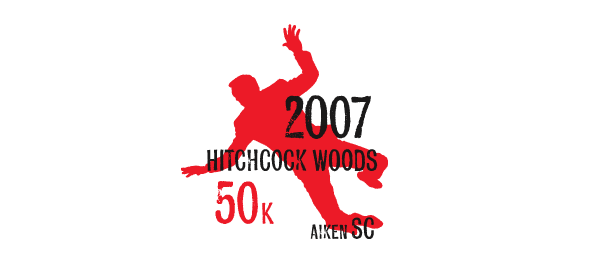Hitchcock Woods 50k
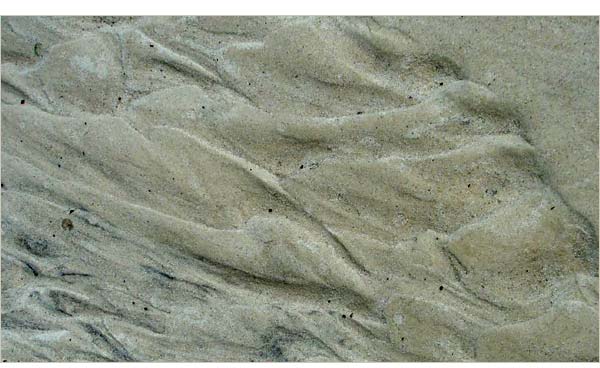
The ubiquitous sands of Hitchcock
Photo: RConaway via Flickr.
Deserts cover more than twenty percent of the earth’s surface. Yet sand covers only a fraction of these areas. Deserts everywhere are expanding, but sand isn’t terribly prevalent; unless of course one has been to Aiken, South Carolina.
About 130 miles inland, Aiken was once oceanfront property. Sixty-five million years ago, in the Paleocene Epoch of the Cenozoic Era’s Paleogene Tertiary Period (naturally part of the Phanerozoic Eon), South Carolina’s coastal plain didn’t exist. It was submerged beneath the sea. In the ensuing and unruly Eocene Epoch (roughly forty-five million years ago), the waters receded and deposited a monstrous amount of sand in what is now Aiken.
It’s still there.
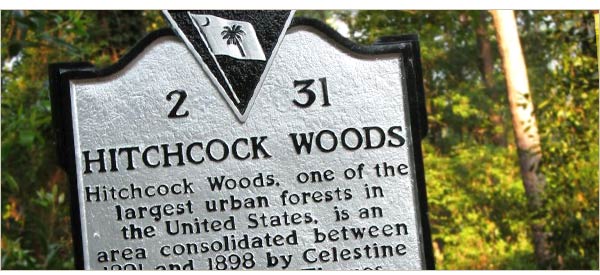
Welcome to Hitchcock Woods.
Photo: charlesing’s via Flickr.
THE RACE
The Hitchcock Woods 50k is held in Aiken’s Hitchcock Woods, a two thousand acre maze of horse paths, single-track trails and abundant sand. Runners must complete three perplexing 10.5 mile loops. But trail distances are notoriously difficult to measure.
A small race of about 30 runners, Hitchcock is purposefully unassuming. As the website warns, it is utterly devoid of bathroom facilities. Restrooms are a luxury available in the pampered environs of outlying society.
The race is run in June, taking full advantage of South Carolina’s stifling heat and humidity. There are no timing chips, cumbersome check-in procedures, cut-off times, computers, expo displays, or copious swag. Though the race director graciously allowed us to make an optional, unofficial shirt.
You show up. You suffer. You go home.
I’d never done an ultra. Like any Pavlovian dog, I signed up because my ultra running friends did. I also sought a challenging mid-year race, and this one was close to home. It was also pretty darn cheap at 10 bucks. I’ve had deeply unsatisfying fast food experiences that cost more.
RECONNAISSANCE
Prior to the race, I received this ominous comment:
“The sand currently is ankle deep in places, and there are a few hills that are just this side of deadly, a lovely combination.â€
My imagination piqued, a friend and I decided to do a reconnaissance run a week before the race.
The entrance to the Hitchcock Woods looks something like an electric sub-station flanked by numerous horse trailers. We spotted the dominant feature immediately: sand. It was everywhere. It was soft, and it was deep.
Running the trails was like running on the beach; not a hard-packed, stale New Jersey beach, but a soft, tropical gulf coast beach bathed in white powder. Few who try to run on the beach make it far before realizing their folly. The stuff is not easy on the feet.
How on earth I could run 50k on sand that looked like it had been imported from Fiji in vast quantities? We even found an aptly named “Sand River.†At one point we spotted a sign reading “Danger: Quicksand after Heavy Rain.†No joke.
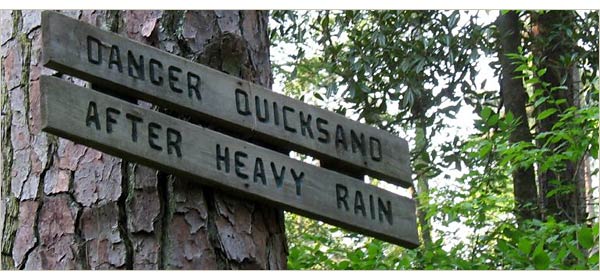
Where’s Bear Grylls when you need him?
Photo: charlesing’s via Flickr.
It was also hot. Drought conditions made the air so dry, you could feel the sand in your throat. We kicked up dust as we ran, all the while dodging horse manure.
The race director offered this statement:
“I think some of the runners are going to be in for a surprise. Don’t let it scare you off – it’s not about time, it’s about finishing.â€
I’ve heard that before. This time I paid attention.
FLASH FLOOD FIFTY
The Weekend of the race, tropical storm Barry struck and it poured cats and dogs. I don’t have proper rain gear, so I made do with cotton baseball caps. This pegged me as either a newbie, or just plain unprepared. I’m not sure which was worse.
We huddled together under a small awning for the pre-race briefing. Shivering and already quite wet, we listened to the race director prepare us for the trails. In a road marathon, there is no run-down of conditions. You line up; the fireworks ignite and off you go. Trails are different. Conditions determine clothing, gear, way finding, and how fast you can reasonably expect to go.
We learned that heavy rain would lead to water accumulation, slippery mud, and difficulty identifying course markings. The Sand River would be an actual river, one that we’d have to cross. In short, the trails would be completely different from our reconnaissance experience.
THE RIBBON METHOD
Course markings were also explained. Each turn would be marked by two orange/red ribbons. Two ribbons on the left side of the trail signaled a left turn. Two ribbons on the right side of the trail signaled a right turn. Once a turn was made, a single orange/red ribbon would be displayed ahead (always on the right) to signal that you were on the correct track. If no ribbons were encountered at an intersection, one should proceed straight (or, in the event a left or right turn had just been made, turn back, since a lack of ribbons indicated that a turn was incorrect). Pink ribbons were to be ignored entirely, regardless of how many there were or what side of the trail they were on.
Once this was explained a few times, someone suggested that we simply make sure that the fastest person knew what to do. The rest would follow like lemmings.
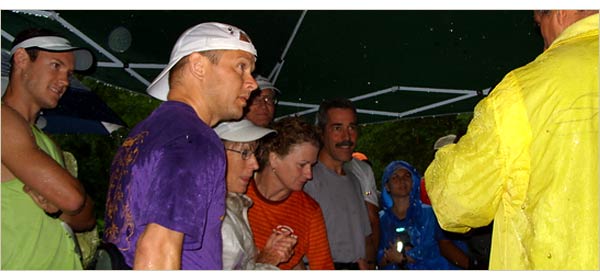
Initial reaction to the explanation of course markings.
Photo: Kevin Hatfield.
We attached our bibs, which were nothing more than dissected FedEx envelopes. Nothing says trail ultra like homemade bibs. After shuffling a few feet to the starting area, an unassuming and anticlimactic “go†signaled the start of our three loop ordeal in the pouring rain.

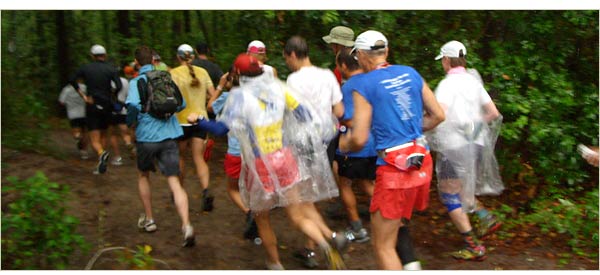
Ten seconds into the race.
Photo: Kevin Hatfield
I decided to try and run with a pal of mine who’s pretty quick. We immediately ran through deep, long, wide puddles, shattering any notion that our feet could remain even partially dry. I tried to avoid the first few but it wasn’t long before I was slogging right through. Good thing my shoes offered superior water drainage.
The puddles were a byproduct of the gloriously providential rain. To many non-runners, rain is cold and unpleasant; something that completely spoils fun. At Hitchcock it was a significant boon. It cooled the air, cooled our bodies, and most importantly, battered down the shifting sand, making it mercifully easier to run upon.
FINDING ALBUQUERQUE
Ten minutes into the race, I missed the first double-right red/orange ribbons. Fortunately, my pal saw the ribbons. It wasn’t the first time that the buddy system would come to the navigational rescue.
The sharp right turn led to stellar single-track trails meandering along a steep ridge: simply gorgeous running. Beyond these trails, we ignored the pink ribbons and came to an intersection. No ribbons. Either we needed go straight (and look for a subsequent ribbon), go back to see if we missed a turn, or simply look to the left or right.
Whew. To the left was a pair of red-orange ribbons. We headed left and hit the first serious hill of the course. Not wanting to waste effort, we walked it, as we did all steep hills. This strategy would pay dividends later.
SWEPT AWAY
Twenty-five minutes in, we came to the infamous Sand River. At least I assume it was once only sand. Now it was a raging, torrential flash flood. It looked like the Yoo Hoo dam had just burst. The chocolaty water rose to mid-calf and featured a brisk current. But the water was delightfully chilly and unexpectedly refreshing.
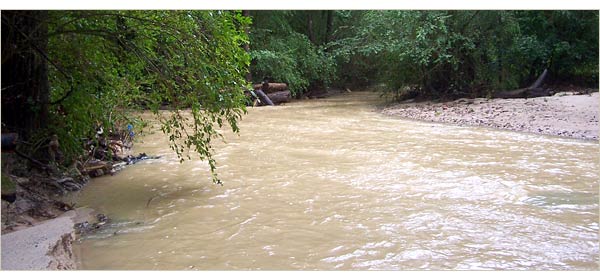
The “Sand” River, from a more sedate flooding. It was far more raucous for us.
Photo: Patrick McQuinn via Flickr.
SWEET, NOURISHING GRUEL
Soon we found the mid-course aid station where the trail reached the side of a road. Here, volunteers parked a car filled with ultra goodies of all sorts including fruit, chips, pretzels, varied confections and disgusting nutrient goo. The cheerful volunteers were exceedingly gracious and helpful. They mentioned something about regretting the horrible weather; an easily forgiven sentiment.
The pouring rain continued, peppered with thunder and lightning. I learned from Man vs. Wild (or was it the Worse Case Scenario Handbook) that running at high elevation under trees, or crossing flash floods during an electrical storm are the exact opposite of recommended behaviors.
THE SIGNPOST UP AHEAD
The second half of the loop featured steeper, longer hills. Staying on course required constant vigilance. Others did not fare as well. In a bizarre circumstance, we were passed by the same runner several times. He’d pass us, get off track and catch us again. I’m sure it was frustrating for him. It was somewhat eerie for us. As if any moment we’d come upon Rod Serling offering a sinister monologue at the side of the trail. Two men thought they were running an ordinary 50k…
ONE DOWN
The loop finished up with a downhill jaunt along a picturesque horse farm. We clocked in at 1:50, and felt it was decidedly more than 10.5 miles.
I switched to a new cotton hat and we were off again.

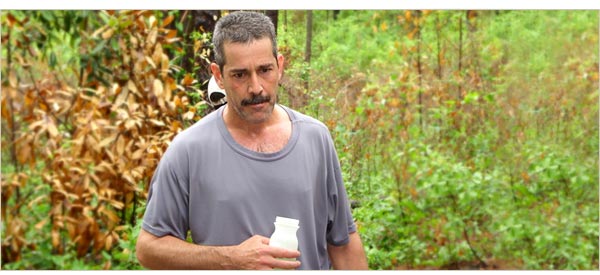
An ultra newbie contemplates two more loops.
Photo: Kevin Hatfield.
We kept our pace, walking the same hills. Though my legs felt heavier, I still felt strong. My pal felt a bit ragged, but didn’t slow down.
The rain continued. All that water had to go somewhere and there’s only one destination for run-off in the Hitchcock woods: the Sand River.
When we reached it again, we discovered the flash flood in all of its ravine carving fury. This time, the torrent was up to my waist (I’m 6’ 2â€) and I was very nearly swept away by the surprisingly powerful current. Fortunately, I kept my footing and made my way to the far bank, feeling like I’d truly left my ultra virginity behind.
At the aid station we heard that we were in 8th and 9th place. Not too shabby. Could we keep this position given the increasingly dull ache in our legs?
GUTTING IT OUT
Ultras are counterintuitive. Hills aren’t dreaded, they’re anticipated. We came to deeply appreciate hills because they signaled walking breaks. After the aid station, we encountered no true hills, and thus no walking. Just miles of pleasantly rolling terrain. It was perhaps the toughest section of the course.
Experiencing the first waves of real fatigue, we encouraged each other by setting small goals: The Sand River bridge, the downed tree, the roots ten feet ahead. This mutual support cannot be overstated. I would have hated to run this race alone, defenseless against my own weak mental constitution. I certainly would have gone slower.
The real problem however, came from my ankles. The sand found its way into my socks and in that annoying gap between my shoes and ankles. There it slowly, inexorably abrased my skin. I think they rely on this technique in the Guantanamo Bay facility. Next year: taller socks.
WALK ON
Toward the end of the loop, we caught up with a runner wearing the same trail shoes (Brooks Cascadia) as me. I’m sure I don’t have to tell you, that’s like wearing the same dress to the prom. At any rate, we passed him, but immediately hit the never-ending Country Road hill and began walking. He chose to run more of the hill and passed us.
But here’s the thing. He did not gap us significantly. We passed him on the ensuing level ground and repeated this process on the next hill. It was like extremely slow motion stock car racing or walk-racing without the ridiculous gait. Walking allowed us to conserve precious vitality for the final loop. We eventually caught the Cascadia doppleganger for good.
2 DOWN
We finished in 1:51, felt as good as could be expected, and had not gotten lost once. Even the rain stopped.

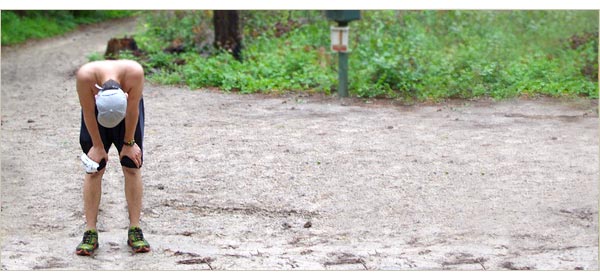
I’m more tired than I look.
Photo: Kevin Hatfield.
Slaves to pain, we set off on tired legs. This time, the walk breaks took a bit more time. Everything seemed to slow a bit. This included the Sand River. Without rain to feed the beast, the waters receded exceedingly quickly, barely rising above our ankles. Many runners likely saw merely damp sand. I certainly wasn’t coming back to check a forth time. We also met an unexpected sight here, another runner. He looked pretty beat. It must be extraordinarily tough to run a race like this alone.
SANS SHIRT
As the sun emerged, my shirt became a burden. It was becoming hot and quite frankly, despite band-aids, my left nipple was on fire. Quickly incapacitated by nipple discomfort, I left my shirt at the aid station. I didn’t get my hopes up about seeing it again.
We were now in 5th and 6th place and we heard, surprisingly, that the leader was just thirty-six minutes ahead. Though barely enough time to get a ten year-old ready for school, at mile thirty it’s just forever. We’d reached our final race position.
We finally got lost when we missed the notorious sharp left turn a mile or so past the aid station, one we’d made correctly twice. Most runners missed this at least once. Still, we correctly quickly and lost only about three to four minutes.
MAKING COWARDS OF US ALL
Fatigue affects both the mind and body. You begin to think incessantly of your own exhaustion. This of course, feeds a downward cycle. Fortunately, my running partner felt strong, and helped immensely. It’s amazing how much simple conversation can do; anything to take the mind off of the overwhelming desire to instantly collapse and order room service.
To make matters worse, toward the end of the loop, the sand dried out as if by time-elapsed photography. It rapidly became more yielding and difficult to run upon. I was fading fast. If this race were two miles longer, I’d be headed for bonkersville. My pal simply would not let me walk.
FINI
As we approached the horse farm, a rush of adrenaline snapped me out from the lethargic fog. We bolted and ran the last hundred yards at a near sprint. Our final time was 5:41:05, tied for 5th place.
At the finish, I dropped to my knees, exhausted. If this had been a road marathon, I’d have been in a wheelchair in seconds and instantly propelled to the medical tent. But this was an ultra. No one paid much attention. After a minute or two, I got up and was unceremoniously offered Gatorade. This is pretty much what I do when my kids fall down or get hurt. I just tell them to quit the theatrics and get up.
The ultra is tough love.
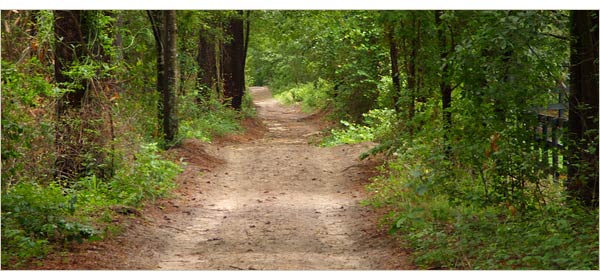
View from the finish line. Great pain was felt here.
Photo: Kevin Hatfield.
POST RACE
Whoever thought of finish line pizza has earned my eternal gratitude. I’m ravenous after long races and the mountain of pizza was most welcome. I’m sure I devoured a full pepperoni pie.
Little things like this made the race worthwhile. We even received unexpected balsa wood finisher’s medals adorned with Alfred Hitchcock’s famed silhouette. This fit nicely with a low key race high on personal touches. The first female finisher was greeted with a makeshift pizza box finishers tape. And I won’t soon forget how her man treated her like royalty at the end of the race. Very cool.
Those nice folks from the aid station even brought back my shirt for me. Now that’s service.
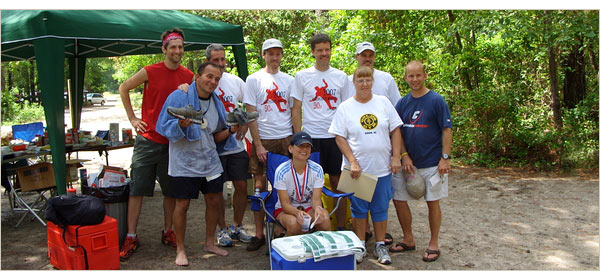
The Columbia Trail Contingent poses with the women’s winner and course volunteer.
Photo: Kevin Hatfield.
AND THE NANO SAYS…
A friend of mine ran with the nifty iPod Nano that tracks distance and regales you with encouraging comments from Lance Armstrong. Forget 50k. The Nano registered Hitchcock in the range of 58k. This takes into account margin of error and lost time. Conservatively, it tracked a 36 mile race. I’m very glad to have learned this AFTER the race rather than before.
THE VERDICT
I loved this race. Here’s the unofficial breakdown:
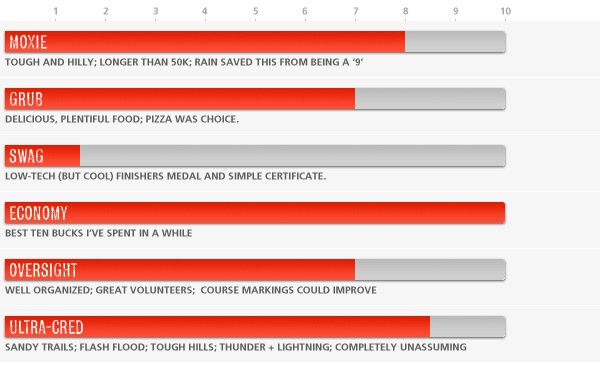
In sum, Hitchcock was well executed, particularly for an inaugural run. It was pleasantly inexpensive and efficiently organized. It featured plentiful food (I ate far more than ten dollars worth), cheerful volunteers, and interesting runners. The course was tough, but we don’t do this for our health, do we?
Of course, no race is perfect.
The post-race buzz centered on difficulty and rain, but more pointedly on course markings. I didn’t have a beef with the ribbon system. Apart from one brief glitch, my pal and I navigated the course perfectly.
I’ve run trail races marked far less well. The Nipmuck Trail Marathon features single-track, technical trails marked only by small blue paint marks on trees. Nipmuck’s course materials actively mock those who lose their way. I got lost four or five times at Nipmuck, once ending up at a lovely waterfall that had nothing to do with the course. Hitchcock’s course, by comparison was well identified. Every turn was marked as advertised.
Still, folks got lost. Many made at least one wrong turn. Some got badly lost. Folks seemed truly good-natured about the experience. Though perhaps those who stewed, stewed silently.
The lack of restrooms deserves mention as well. A single port-o-john at the start-finish would have benefited the runners immensely. But, perhaps horses get spooked by blue obelisks on the trails. Who knows?
LOOKING FORWARD
In 2008, the Hitchcock 50k will probably be more clearly marked. But it will almost certainly be tougher. Without the benefit of steady rain to pulverize the sand, this race will wreak havoc on unprepared feet. This year, temperatures were ideally situated in the mid 60s. Days later, South Carolina roasted in the upper 90s. Expect a furnace next year.
My advice for 2008 Hitchcock participants? Bring a running buddy and do a rain dance the night before.
– Dean
(If you want to comment on this race report, head on over to the originating post, “Raw and Honest”.)
